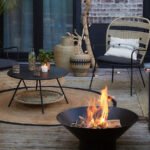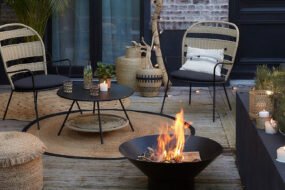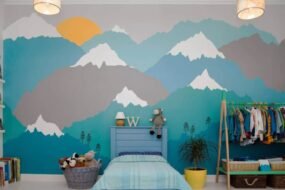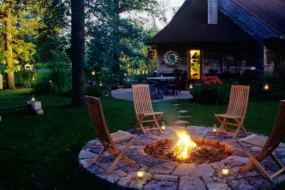
Introduction – Your Home, Your Mind
Our homes are more than just walls and furniture — they’re reflections of our emotions, habits, and state of mind. A cluttered room can make you feel overwhelmed. A dim space can drain your energy. A thoughtfully designed one, though, can bring calm, clarity, and joy.
In recent years, interior design has evolved beyond color palettes and furniture trends. Now, neuroarchitecture and environmental psychology — the study of how space affects behavior and emotion — are shaping how we design our homes.
Whether you’re remodeling a single room or reimagining your entire home, understanding the psychology of space helps you design not just for beauty, but for balance.
1. The Science of Space Psychology
Every texture, color, and layout in your home has a psychological impact. Studies show that people exposed to natural light feel more energetic, while those surrounded by clutter experience higher stress levels.
The brain constantly reacts to its surroundings. Open layouts encourage social interaction. Low ceilings promote focus. Warm colors stimulate energy, while cool tones calm the mind.
Key principles of spatial psychology include:
- Light: Affects mood, alertness, and even circadian rhythms.
- Color: Influences emotion — reds energize, blues soothe.
- Form and Flow: The movement through space affects ease and comfort.
- Texture: Soft fabrics bring comfort; sleek surfaces add sophistication.
- Nature (Biophilia): Humans are hardwired to feel relaxed when connected to nature.
When applied thoughtfully, these principles transform ordinary rooms into mood-shaping environments.
2. Lighting – The Invisible Design Powerhouse
Light is one of the most powerful emotional tools in design. It dictates how we perceive color, shape, and depth — and profoundly influences our mental state.
Natural Light: The Ultimate Mood Booster
Sunlight triggers serotonin, the “happiness hormone.” Homes with large windows, skylights, or reflective surfaces feel more open and alive.
- Use sheer curtains to diffuse natural light softly.
- Add mirrors opposite windows to amplify brightness.
- For dark spaces, use daylight bulbs to mimic the sun’s spectrum.
Artificial Lighting: Layer It Right
Balanced lighting is all about layering:
- Ambient lighting: General room illumination.
- Task lighting: Focused lights for activities (e.g., reading lamps).
- Accent lighting: Adds mood — think LED strips under shelves or art spotlights.
Pro tip: Warm light (2700K–3000K) creates comfort; cool white (4000K–5000K) boosts concentration. Adjust your lighting based on the function of each room.
3. The Emotional Power of Color
Color psychology is central to mood-based remodeling. Each shade carries subconscious messages and affects how a space feels.
Blue – The Calm Creator
Perfect for bedrooms and bathrooms, blue evokes serenity and lowers blood pressure. Pale blues expand small rooms, while navy tones add sophistication.
Green – The Balance Keeper
Green mirrors nature — symbolizing renewal and peace. Use it in living rooms or offices to reduce eye strain and encourage creativity.
Yellow – The Happiness Highlighter
Great for kitchens or entryways, yellow sparks optimism and energy. But avoid using too much — it can overstimulate in large doses.
Gray and Neutrals – The Grounding Tones
Neutral palettes provide emotional balance. Use them as a backdrop for bolder colors or textures to create a timeless, tranquil foundation.
Red – The Energy Driver
Ideal for dining areas or gyms, red encourages conversation and passion. Use sparingly as an accent color to avoid overwhelming the senses.
Color isn’t just about preference — it’s a form of emotional engineering.
4. Declutter to Destress
Clutter doesn’t just take up space — it takes up mental bandwidth. A disorganized environment increases cortisol levels, making it harder to relax or focus.
Start with Zones:
Break your home into categories — living, sleeping, eating, working — and declutter one at a time.
Adopt the “One-In, One-Out” Rule:
Every time you bring in something new, remove one old item. This keeps accumulation in check.
Storage as Design:
- Use built-in shelving for hidden organization.
- Add multi-functional furniture like ottoman storage.
- Display only meaningful items — let your space breathe.
A decluttered home promotes clarity, productivity, and peace. It’s not just cleaner — it’s calmer.
5. Biophilic Design – Bringing Nature Indoors
Humans naturally thrive in connection with nature — a concept called biophilia. Integrating organic elements into your home has measurable mental health benefits: reduced stress, better sleep, and higher creativity.
Ways to introduce biophilic design:
- Indoor Plants: From snake plants to fiddle leaf figs — they clean the air and add vibrancy.
- Natural Materials: Choose wood, linen, clay, and stone over synthetics.
- Water Features: The sound of trickling water adds tranquility.
- Nature Views: Frame your furniture to face windows or gardens.
- Earthy Colors: Greens, browns, and muted blues promote calm.
Even a small touch — like a potted plant near your workspace — can improve focus and lower anxiety.
6. Room-by-Room Remodeling for Better Mood
Each space in your home serves a unique emotional purpose. Here’s how to remodel with intention:
Living Room – Connection and Comfort
- Use open layouts to encourage togetherness.
- Choose soft lighting and layered textures (plush rugs, throw blankets).
- Add a focal point like a fireplace or art wall to create grounding energy.
Bedroom – Rest and Renewal
- Keep technology minimal.
- Choose cool colors (blue, lavender, taupe).
- Invest in high-quality bedding and blackout curtains for sleep health.
Kitchen – Warmth and Nourishment
- Add warm tones (yellows, soft oranges) to stimulate appetite.
- Use open shelving to reduce visual clutter.
- Incorporate natural materials like wood and ceramic.
Home Office – Focus and Flow
- Place your desk near a natural light source.
- Use greens and neutral tones for concentration.
- Keep the backdrop simple — it influences your mental energy during work.
Bathroom – Calm and Clarity
- Spa-inspired design with neutral tiles, warm lighting, and plants.
- Use aromatherapy (eucalyptus or lavender) for relaxation.
- Declutter surfaces — visual peace equals mental peace.
7. The Power of Layout – Designing Flow and Energy
The way furniture and pathways are arranged shapes your home’s emotional rhythm.
In spatial psychology, flow means the ease with which people move and feel within a space.
Good Flow Feels Like:
- Natural movement without obstacles.
- Open sight lines that make rooms feel larger.
- Balanced visual weight — no cluttered corners or awkward furniture clusters.
Layout Tips:
- Leave at least 3 feet of walking space around furniture.
- Position seating to encourage conversation.
- Use rugs to define functional zones.
- Apply Feng Shui principles for balance — for example, keep beds facing doors but not directly aligned with them.
When energy flows freely through your home, your mind follows.
8. Designing for Emotional Diversity
A truly happy home supports multiple moods: peace, creativity, focus, and connection. Here’s how to design for emotional diversity:
- Calm Corners: Add a reading nook or meditation area.
- Creative Zones: Use bright light and color to boost inspiration.
- Social Spaces: Arrange furniture in circular or semi-open shapes.
- Solo Retreats: Create private, quiet areas for unwinding.
Balancing stimulation and stillness keeps your home emotionally dynamic and adaptable.
9. Technology and Mental Balance
Smart homes can enhance well-being — when used mindfully.
- Smart lighting systems: Adjust color temperature based on time of day.
- Soundscaping: Use smart speakers for nature sounds or calming playlists.
- Air quality sensors: Maintain healthy humidity and circulation.
- Digital boundaries: Keep “tech-free” zones to avoid overstimulation.
Technology should serve serenity — not steal it.
10. Conclusion – Build a Home That Heals
A well-designed home isn’t just seen — it’s felt. It embraces you after a long day, supports your ambitions, and nourishes your mind.
When remodeling, think beyond trends. Focus on how you want to feel in each space. Do you want calm mornings? Energizing afternoons? Restful nights?
Design your home around emotion, not aesthetics alone.
The psychology of space reminds us that every detail matters — from sunlight streaming through a window to the curve of a chair. Because in the end, we don’t just live in our homes. Our homes live in us.






